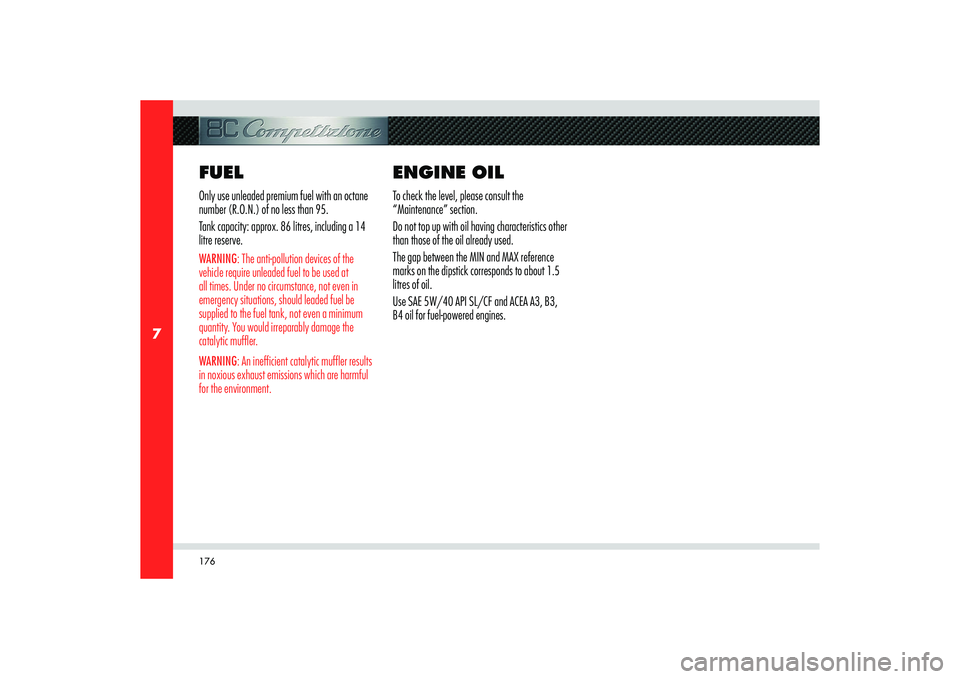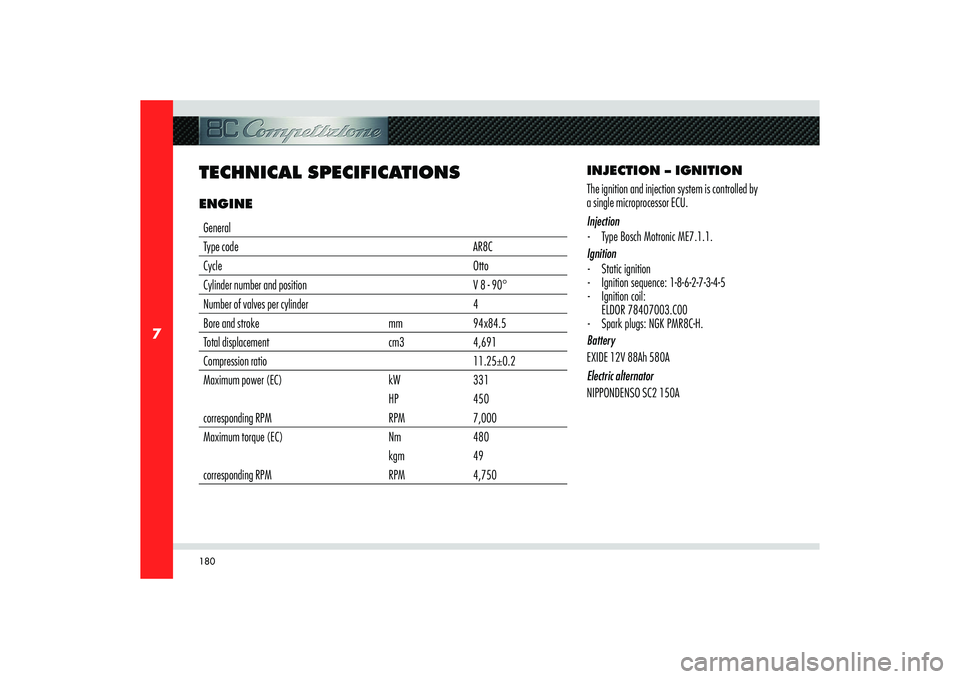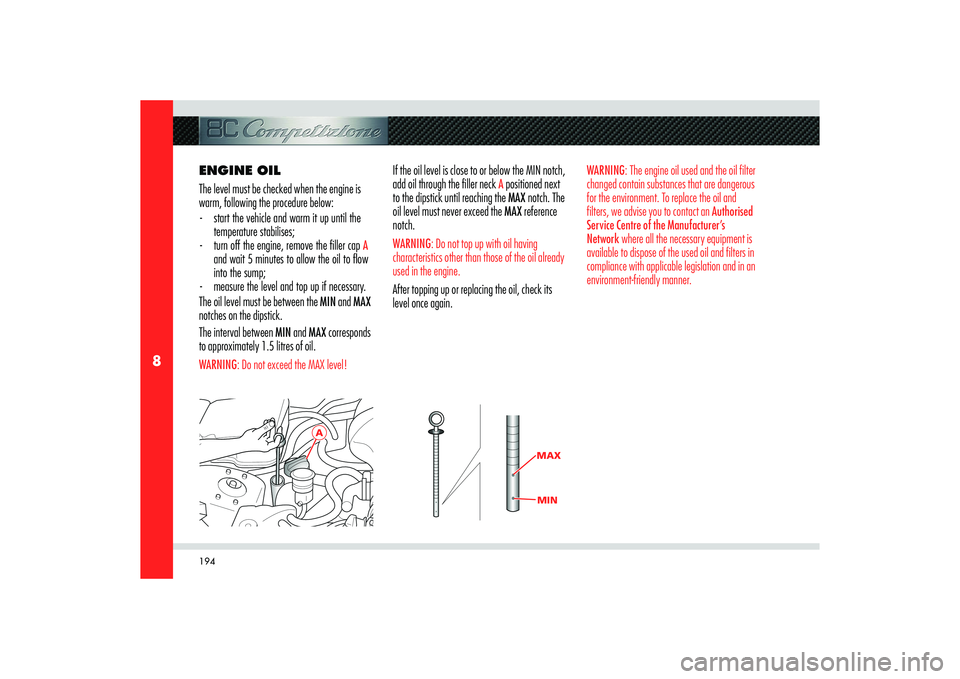ESP Alfa Romeo 8C 2010 Owner handbook (in English)
[x] Cancel search | Manufacturer: ALFA ROMEO, Model Year: 2010, Model line: 8C, Model: Alfa Romeo 8C 2010Pages: 223, PDF Size: 14.35 MB
Page 178 of 223

176
7
FUELOnly use unleaded premium fuel with an octane
number (R.O.N.) of no less than 95.
Tank capacity: approx. 86 litres, including a 14
litre reserve.WARNING: The anti-pollution devices of the
vehicle require unleaded fuel to be used at
all times. Under no circumstance, not even in
emergency situations, should leaded fuel be
supplied to the fuel tank, not even a minimum
quantity. You would irreparably damage the
catalytic muffler.
WARNING: An inefficient catalytic muffler results
in noxious exhaust emissions which are harmful
for the environment.
ENGINE OILTo check the level, please consult the
“Maintenance” section.
Do not top up with oil having characteristics other
than those of the oil already used.
The gap between the MIN and MAX reference
marks on the dipstick corresponds to about 1.5
litres of oil.
Use SAE 5W/40 API SL/CF and ACEA A3, B3,
B4 oil for fuel-powered engines.
Page 182 of 223

180
7
TECHNICAL SPECIFICATIONSENGINEGeneral
Type code AR8C
Cycle Otto
Cylinder number and position V 8 - 90°
Number of valves per cylinder 4
Bore and stroke mm 94x84.5
Total displacement cm3 4,691
Compression ratio 11.25±0.2
Maximum power (EC) kW 331
HP 450
corresponding RPM RPM 7,000
Maximum torque (EC) Nm 480
kgm 49
corresponding RPM RPM 4,750INJECTION – IGNITION
The ignition and injection system is controlled by
a single microprocessor ECU.
Injection
- Type Bosch Motronic ME7.1.1.
Ignition
- Static ignition
- Ignition sequence: 1-8-6-2-7-3-4-5
- Ignition coil:
ELDOR 78407003.C00
- Spark plugs: NGK PMR8C-H.
Battery
EXIDE 12V 88Ah 580A
Electric alternator
NIPPONDENSO SC2 150A
Page 192 of 223

190
8
SCHEDULED
MAINTENANCECorrect maintenance is clearly the best way
to maintain vehicle performance and safety
features, ensure respect for the environment and
low operating costs.WARNING: Also remember that the scrupulous
observance of the maintenance procedures is
essential for the validity of the warranty.For this reason, Alfa Romeo has provided for
a series of checks and maintenance operations
involving the 1
st service when the vehicle
mileage reaches 5,000 km or after 6 months of
the vehicle life, and subsequently every 10,000
km or every year. AFTER THE 11
TH SERVICE
After the 11
th service, scheduled maintenance is
restarted with the same operations performed for
the 1
st, 2nd, 3rd Services
WARNING: The Scheduled Maintenance services
are prescribed by the Manufacturer. Failure to
have the services carried out invalidates the
warranty.
Scheduled Maintenance Services are
provided by all Authorised Service Centres
of the Manufacturer’s Network. In the
event that, when a service is performed,
further replacements or repairs are found to
be necessary in addition to the scheduled
operations, these can be carried out only with
the specific consent of the Customer. WARNING: We advise you to immediately
report to an Authorised Service Centre of the
Manufacturer’s Network any small operating
failures and not to wait for the next service.The Maintenance Schedule is contained in the
“Warranty and Maintenance Schedule” book.
Page 196 of 223

194
8
A
MAXMIN
ENGINE OIL
The level must be checked when the engine is
warm, following the procedure below:
- start the vehicle and warm it up until the
temperature stabilises;
- turn off the engine, remove the fi ller cap
A
and wait 5 minutes to allow the oil to fl ow
into the sump;
- measure the level and top up if necessary.
The oil level must be between the MIN and MAX
notches on the dipstick.
The interval between MIN and MAX corresponds
to approximately 1.5 litres of oil.
WARNING: Do not exceed the MAX level!
If the oil level is close to or below the MIN notch,
add oil through the filler neck
A positioned next
to the dipstick until reaching the MAX notch. The
oil level must never exceed the MAX reference
notch.
WARNING: Do not top up with oil having
characteristics other than those of the oil already
used in the engine.After topping up or replacing the oil, check its
level once again.
WARNING: The engine oil used and the oil filter
changed contain substances that are dangerous
for the environment. To replace the oil and
filters, we advise you to contact an Authorised
Service Centre of the Manufacturer’s
Network where all the necessary equipment is
available to dispose of the used oil and filters in
compliance with applicable legislation and in an
environment-friendly manner.
Page 203 of 223

201
8
MAINTENANCE
HOW TO USE THE TYRESWARNING: The tyres must be constantly kept in
good conditions to ensure safe driving.Tyre inflation pressure must correspond to the
prescribed values and should be checked only
when the tyres are cold: the pressure increases
as the tyre temperature progressively increases.
Never reduce the pressure if tyres are warm.
Insufficient tyre inflating pressure can cause tyre
overheating and possible internal damages,
which may even lead to the tyre destruction.
CAUTION
Check the tyre inflating
pressure at least every two weeks and
before long trips.
Impacts with kerbs, holes, and obstacles in the
road, as well as prolonged trips on rough roads
can cause tyre damage which may not be visible
to the naked eye.
Check your tyres regularly for any signs of
damage (e.g. scratches, cuts, cracks, bulges,
etc.).
If sharp objects penetrate the tyres, they can
cause damage which is only visible when the tyre
is removed.
In any case, any possible damage must be
inspected by an experienced tyre fitter, as it may
seriously reduce the tyre life.
Remember that tyres deteriorate with time, even
if used little or not at all.
Cracks in the tyre tread and sides, alongside
possible bulging, are a sign of deterioration.
CAUTION
Have the old tyres inspected
by an experienced tyre fitter, to make
sure they can still be used safely. If the
same tyre has been on your vehicle for
4 or 5 years, have it inspected anyway
by an experienced tyre fitter.
CAUTION
Never fit tyres of uncertain
origin.
CAUTION
“Directional” tyres have an
arrow on their side showing the
rolling direction. To maintain optimal
performance when replacing a tyre,
make sure that the rolling direction
corresponds to the one marked by the
arrow.